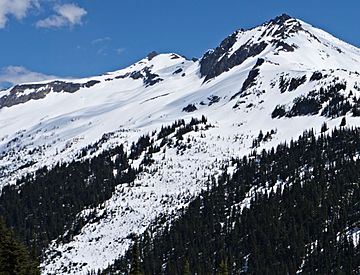North Star Mountain facts for kids
Quick facts for kids North Star Mountain |
|
|---|---|

North Star centered, with Cloudy Peak upper right
As seen from Suiattle Pass |
|
| Highest point | |
| Elevation | 8,096 ft (2,468 m) |
| Prominence | 936 ft (285 m) |
| Isolation | 1.35 mi (2.17 km) |
| Parent peak | Bonanza Peak 9,511 ft |
| Geography | |
| Location | Glacier Peak Wilderness Chelan County, Washington, U.S. |
| Parent range | North Cascades Cascade Range |
| Topo map | USGS Suiattle Pass |
| Geology | |
| Age of rock | Cretaceous |
| Climbing | |
| Easiest route | Scrambling |
North Star Mountain is a tall mountain in Washington state. It's about 8,096 feet (2,468 meters) high. You can find it in the beautiful Glacier Peak Wilderness area, which is part of the North Cascades mountain range in Chelan County.
Nearby mountains include Cloudy Peak, which is about 0.9 miles (1.4 km) away to the southwest. The closest mountain that's even taller is Bonanza Peak, located about 1.9 miles (3.1 km) to the northeast.
Interestingly, North Star Mountain and Bonanza Peak once had their names swapped! The U.S. Geological Survey (USGS) made a mistake on their first map in 1904, and the names have stayed that way ever since. Rain and melting snow from North Star Mountain flow into Agnes Creek and Railroad Creek. These creeks then join the Chelan River.
How North Star Mountain Was Formed
North Star Mountain is part of a large rock formation called the Cloudy Pass batholith. A batholith is a huge mass of igneous rock that formed deep underground. This particular one was created about 20 million years ago, during a time called the early Miocene epoch.
The Cascade Mountains, where North Star Mountain is located, started forming millions of years ago. This happened because the North American Plate (a huge section of Earth's crust) slowly moved over the Pacific Plate. This movement caused a lot of volcanic activity.
Glacier Peak, a large cone-shaped volcano called a stratovolcano, began forming about 12.5 miles (20.1 km) southwest of North Star Mountain. Also, small pieces of Earth's crust, called terranes, came together to create the North Cascades about 50 million years ago.
Ice and Earthquakes
During the Pleistocene period, which started over two million years ago, huge sheets of ice called glaciers repeatedly covered and then melted away from the land. These glaciers carved out the landscape, creating the deep valleys and tall peaks we see today. Most valleys were free of ice about 12,000 years ago.
The mountains also rose up due to forces within the Earth, a process called orogeny. This, along with faulting (where cracks in the Earth's crust cause sections to move), helped shape the tall peaks of the North Cascades. The movement of Earth's plates and volcanic activity in this area began about 90 million years ago. A lot of volcanic activity also happened around 35 million years ago.
Mountain Climate and Weather
North Star Mountain is in a marine west coast climate zone. This means it gets a lot of moisture from the Pacific Ocean. Most weather systems, like storms, start over the Pacific and move northeast towards the Cascade Range.
When these weather systems hit the tall peaks of the North Cascades, the air is forced to rise. As the air goes higher, it cools down and drops its moisture as rain or snow. This process is called Orographic lift. Because of this, the western side of the North Cascades gets a lot of rain and snow, especially in winter.
This snowy climate helps support the Grant Glacier, which sits in a bowl-shaped hollow called a cirque on the north side of the mountain. In winter, it's often cloudy. However, in summer, high-pressure systems over the Pacific Ocean usually bring clear skies. Because the snow is influenced by the ocean, it tends to be wet and heavy. This can create a high risk of avalanches.



